Zeus and His Dysfunctional Family
8 Hephaestus
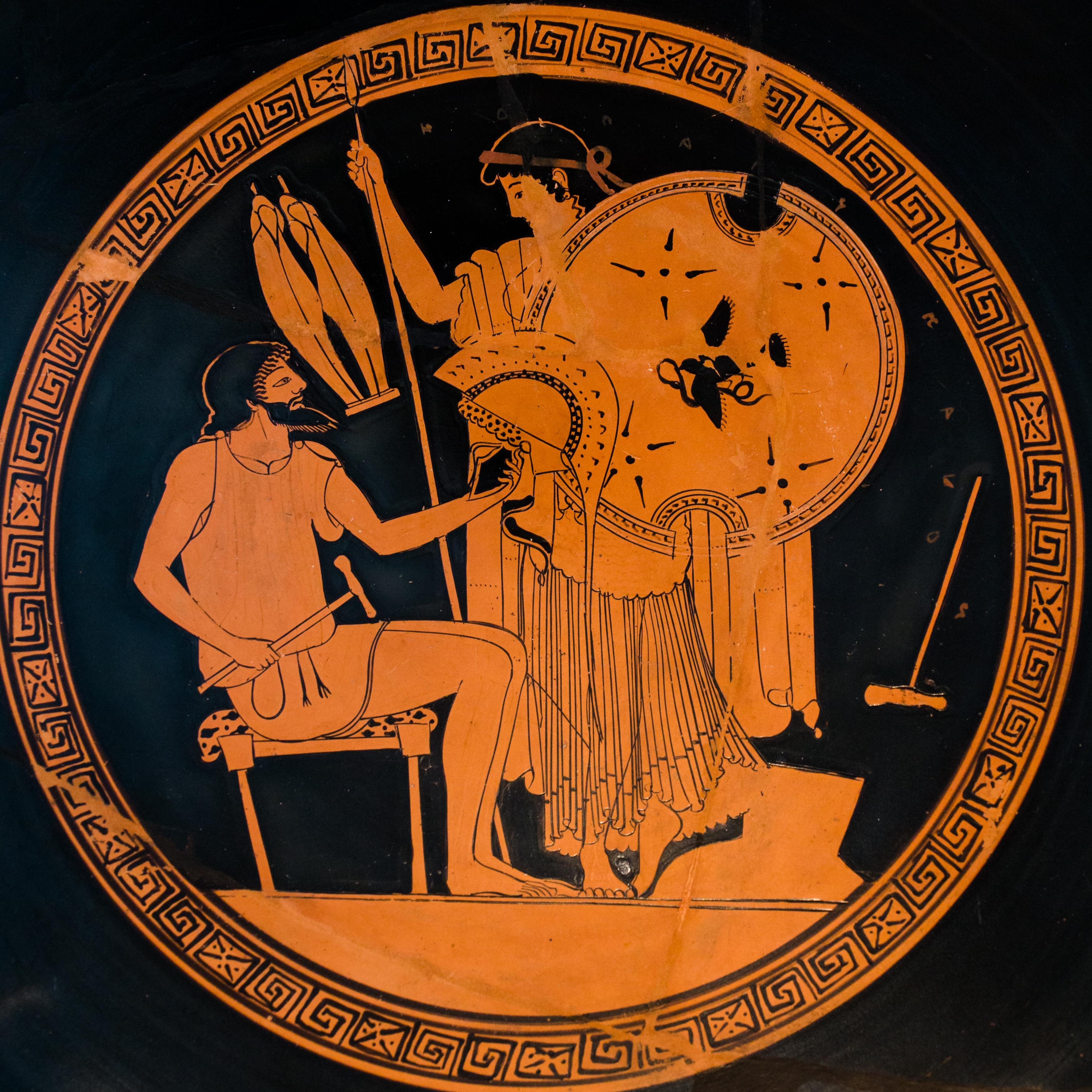
Origins
Sections & Primary Sources
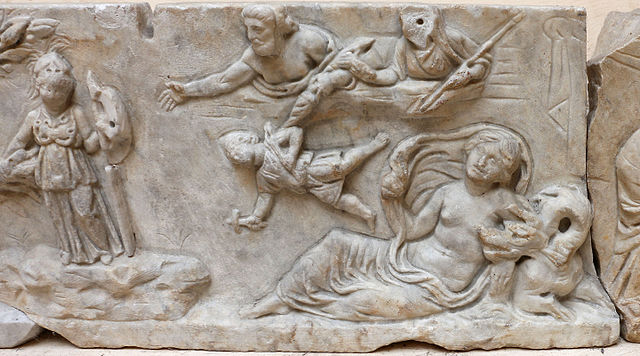
The following content is adapted from Mythology Unbound and is licensed under a CC BY-NC-SA license.
[content warning: ableism, child abuse, and attempted infanticide]
Hephaestus was sometimes considered the son of both Zeus and Hera. Other accounts, however, say that Hera gave birth to Hephaestus parthenogenically, in response to Zeus giving birth to Athena by himself.
In some versions of his birth, Hephaestus was born with a clubfoot. Hera was displeased with her son’s disability and threw him off Mount Olympus. Hephaestus landed in the sea where he was cared for by the sea goddesses, Thetis and Eurynome, while he grew. He soon proved to be a master craftsman, and he built a beautiful throne for his mother that trapped her when she sat in it. Numerous gods tried to convince Hephaestus to release Hera, but he refused until Dionysus came and got Hephaestus drunk. This aid is cited as the reason why Hera ultimately put aside her hatred of Dionysus.
According to another version of his birth myth, Hephaestus was born without a disability, but when he intervened on behalf of his mother in a dispute between his parents, Hera and Zeus, Zeus flung Hephaestus off of Mount Olympus. Hephaestus fell for a full day until he crashed onto the island of Lemnos. The Lemnians took care of him as well as they could, but Hephaestus always walked with a limp afterwards. The god was grateful to the Lemnians and established his workshop on the island.
The Romans, whose counterpart for Hephaestus was the god Vulcan, claimed that Vulcan’s forge was located beneath Mount Etna on the island of Sicily. When the volcano on Mount Etna erupted, the Romans said that Vulcan was working in his forge.
God of Crafts
Hephaestus’ timé included fire, metalwork, invention, volcanoes, and general craftsmanship.
“Homeric Hymn 20 To Hephaestus” (trans. H. G. Evelyn-White, adapted by L. Zhang)
Greek hymn, ca. 7th – 4th century BCE
[1] Sing, clear-voiced Muses, of Hephaestus famous for his inventions. With bright-eyed Athena he taught men glorious gifts throughout the world, men who had previously been living in caves in the mountains like wild beasts. But now that they have learned crafts through Hephaestus the famed worker, they easily live a peaceful life in their own houses the whole year round. Be gracious, Hephaestus, and grant me success and prosperity!
Taken from: https://www.theoi.com/Text/HomericHymns3.html#20
Hephaestus in Action
[content warning for the following sources: ableism]
Sections & Primary Sources
Hephaestus, Aphrodite, and Ares
The following content is adapted from Mythology Unbound and is licensed under a CC BY-NC-SA license.
Hephaestus was married to Aphrodite, but theirs was not a happy union. Aphrodite had a long-standing affair with the war god, Ares. Whenever Hephaestus would leave home, Aphrodite and Ares would jump into bed. When the sun god, Helios, informed Hephaestus of what his wife did while he was away, Hephaestus came up with a plan to catch the two in the act. He built a golden net which was so fine that it was invisible and set it up above his bed. He then told his wife that he was taking a trip to Lemnos to visit his forge and hid. Soon, Aphrodite and Ares were in the bed together and the net fell upon them, trapping them right where they were. Hephaestus came in with all the other Olympians to jeer at the lovers, who were caught in the act.
Homer, Odyssey, Book 8 (trans. A. S. Kline, adapted by T. Mulder)
Greek epic poem, 8th century BCE
[256-366] Then the bard struck the chords that began his sweet song, and told of the love of Ares and Aphrodite of the lovely crown, how they lay together in secret in Hephaestus’ house, and how Ares gave her a host of gifts while dishonouring the Lord Hephaestus’ bed. But Helios, the sun god, who had spied them sleeping together, came to tell him. When Hephaestus had heard the sour tale, he went to his workshop with his heart set on evil, and set up his huge anvil on its block, and forged a net of chains, firm and unbreakable. And when, furious with Ares, he had made the snare, he went to his room and marriage bed, and fastened the netting to its posts, and hung its links above from the roof beams, fine as a spider’s web, and so cunningly made it was invisible even to the blessed gods.
When he had spread his net over the bed, he pretended to leave for Lemnos, that well-ordered citadel, dearest of all the islands to his eyes. Nor was Ares of the Golden Reins blind to the master-craftsman Hephaestus’ going, but went straight to his house, hot for the love of Cytherea of the lovely crown. She had scarcely left her father’s [ Zeus‘ ] presence, that of mighty Cronus’ son, and seated herself on arriving, when Ares entered and took her hand and spoke to her: ‘Sweetheart, come, let us go to bed, and take delight in mutual love. Hephaestus has left, for Lemnos no doubt, to visit the Sintians, who speak like barbarians.’
As he spoke it seemed a pleasant thing to her to lie with him. So they went to the bed and lay down. Then clever Hephaestus’ cunning net fell all around them, and they were unable to move or raise themselves. They soon realised there was no escape. Now the great disabled god approached, for Helios had kept watch and carried the word, and Hephaestus returned before ever reaching Lemnos. He came home, troubled in mind, and as he stood in the gateway a terrible anger seized him. And he cried out fiercely to all the gods:
‘Father Zeus, and all you other blessed and immortal gods, come, see something laughable, and intolerable, how Aphrodite, daughter of Zeus, scorning me for my disability, makes love with hateful Ares because he is straight-limbed and handsome while I was born crooked. My parents alone are to blame for that: I wish they had never made me! Look how these two usurp my bed and sleep together, while I am filled with pain to see it. Yet they won’t want to lie like this much longer, I think: no, not for an instant, however much they are in love. They’ll soon lose their urge for bed, the net and its links will hold them instead till her father repays me all the gifts I gave him while wooing this dog-eyed girl, a beautiful daughter indeed but faithless.’
At this the gods came crowding the bronze threshold: Poseidon, Earth-Bearer, Hermes the messenger, and Lord Apollo who strikes from afar. The goddesses stayed at home from modesty, but those deathless ones, givers of good, stood in the entrance, and when they saw clever Hephaestus’ snare, unquenchable laughter flowed from the blessed gods. One would glance at his neighbour and say: ‘Ill deeds don’t prosper. The slow catch the swift, as Hephaestus here, slow as he is, has netted Ares the swiftest of all the Olympian gods. He has trapped him by cunning, though disabled. Ares must pay the fine for adultery.’
Such were the comments, then Lord Apollo, son of Zeus, said to Hermes: ‘Guide and Giver of Good Things, Hermes, Zeus’ son, would you not care to lie in bed beside golden Aphrodite, even though you were snared by unbreakable chains?’
The Messenger-God, Slayer of Argus, replied: ‘Lord Apollo, Far-Shooter, three times as many inescapable links could hold me, and you gods could be watching, and yes, all the goddesses too, if only I might sleep with golden Aphrodite.’
At this, laughter rose from the group of immortal gods. But Poseidon was unsmiling, and kept begging Hephaestus, the master craftsman, to set Ares free, speaking with winged words: ‘Set him free, and I promise what you ask, that he’ll pay what’s owed in the presence of the deathless gods.’
The illustrious disabled god replied: ‘Poseidon, Earth-Bearer, don’t ask this of me. It’s a sad mistake for sure, to stand surety for a sad rogue. Will I bind you with chains, in the presence of the deathless gods, if Ares shrugs off both chains and debt, and escapes?’
But Poseidon, said again: ‘If Ares shrugs off the debt and escapes, Hephaestus, I will pay it myself.’
To this, the illustrious disabled god replied: ‘Well, I can’t refuse you, it wouldn’t be right.’ And he loosed the net, and the two of them, free of the chains, leaped up quickly and fled. Ares headed for Thrace, but laughter-loving Aphrodite to Paphos in Cyprus, where she has a sanctuary and fragrant altar. There the Graces bathed her, and anointed her with such heavenly oil as gleams on the limbs of the gods who live forever. And they dressed her in beautiful clothes, marvellous to behold.
Taken from: https://www.poetryintranslation.com/PITBR/Greek/Odyssey8.php#anchor_Toc90267758
Translated by A. S. Kline © Copyright 2004 All Rights Reserved
Hephaestus Makes Armour for Achilles
Homer, Iliad, Book 18 (trans. A. S. Kline, adapted by T. Mulder)
Greek epic poem, 8th century BCE
[content warning for the following source: violence]
[368-467] Silver-footed Thetis reached Hephaestus’ house of imperishable bronze, adorned with stars and finest among those of the immortals, built by the limping god himself. She found him running back and forth to his bellows, sweating with toil, as he fashioned twenty triple-legged tables to stand round the walls of his great hall. He had fitted their legs with golden wheels, so they might take themselves to the gods’ assembly if he wished, and roll home again, a wondrous sight. They were not quite finished, still lacking elaborate handles which he was burnishing while forging their rivets. It was as he laboured at these with all his care and skill that silver-footed Thetis approached.
Lovely Charis of the glistening veil, wife of the illustrious limping god, seeing her, came forward, took both her hands in hers and spoke: ‘Thetis of the long robe, honoured and welcome, though unaccustomed, guest, what brings you here? Follow me inside, so I may offer you hospitality.’
So saying she led the goddess inside, and made her sit on a splendid chair, elaborately adorned with silver studs, and with a footstool beneath. Then she summoned Hephaestus, the master-smith: ‘Hephaestus, come quickly! Thetis has need of you.’ Hephaestus answered at once: ‘Ah, a goddess I honour and revere is here in my house, she who saved me in my hour of agony, after my mother Hera, shamed by my disability, threw me from Olympus. How I’d have suffered if Thetis and Eurynome, daughter of encircling Ocean, had not taken me to their breasts. Staying with them nine years in their deep cave, I worked away at fine ornaments; brooches and spiral bracelets, necklaces and rosettes; while round me the vast stream of Ocean flowed, seething with foam. Neither gods nor mortals knew, only Thetis and Eurynome who rescued me. Now Thetis is here, and I must repay her fully for saving my life. Show her hospitality, while I put my tools and bellows away.’
So saying, his huge form rose from the anvil, and panting heavily, he limped about, though agile enough on his withered legs. He moved the bellows from the fire, and collecting his tools together placed them in a silver chest. Then he wiped his hands and face, huge neck, and shaggy breast with a sponge and donned his tunic. Grasping a thick staff he limped from the forge, supported by servants made of gold, fashioned like living girls, who attended swiftly on their master. As well as the use of their limbs they had intellect, and the immortals gave them skill in subtle crafts. They supported Hephaestus as he limped towards Thetis, and seated himself on a gleaming chair. Then he took her hand and spoke to her: ‘Thetis of the long robe, honoured and welcome, though unaccustomed, guest, what brings you here? Say what you need, and my heart prompts me to fulfill it, if it can be done, and I can do it.’
Thetis, weeping, answered: ‘Is there a goddess, Hephaestus, who has suffered more heartfelt sorrows at the hands of Zeus, than I? I alone of all the daughters of the sea he wedded to a mere human, Peleus, son of Aeacus, and unwillingly it was that I lay with a mortal man. He keeps to his palace now, weighed down sadly by the years, while I suffer further grief. I brought a mighty and peerless son into this world, greatest of warriors. I nursed him like a shoot in a fertile orchard, and like a sapling he grew swiftly. I sent him to Ilium with the beaked ships, to fight the Trojans, but I shall never welcome him home once more to the house of Peleus. And even now, while he lives and knows the light of day, he suffers, beyond my help, though I go to him. King Agamemnon has taken from him the girl [ Briseis ] the Achaeans gave him as a prize. Wasting his heart in grief for her, he refused to ward off ruin from the Greeks, despite the elders offering him fine gifts, and the Trojans penned them in by their ships sterns, and proved immoveable. Then he let Patroclus don his own armour and join the battle, with his Myrmidons. All day they fought by the Scaean Gate, and would have sacked the city, if Apollo had not caused the death of brave Patroclus at the height of his success, and granted the final act to Hector. So I have come to clasp your knees, and ask you to give my son, who is doomed to an early death, a shield and helmet, a breastplate and bronze greaves fitted with ankle-pieces, to replace the armour lost when the Trojans killed his faithful friend, for whom my son now lies in the dust struck with grief to his very heart.’
The master-smith replied: ‘Take heart, and be easy in your mind. I wish that I could save him from sad death, when the fateful time arrives, as easily as I can grant him splendid armour, splendid enough to make many a man marvel who gazes on it some fine day.’
[468-617] With this, Hephaestus returned to his forge, turned his bellows on the fire, and ordered them to begin. The set of twenty nozzles blew on the crucibles, sending out a varying blast of air at need, aiding his careful efforts as required, at every stage of the work. Into the crucibles went stubborn bronze, tin, precious gold and silver. He set up a great anvil on its block, and took a massive hammer in one hand and a pair of tongs in the other.
Then he first made a shield, broad and solid, adorning it skilfully everywhere, and setting round it a glittering triple rim, with a silver strap attached. Five layers it had, and he decorated it with subtle art.
On it he showed the earth, sea, sky, the tireless sun and the full moon, and all the constellations that crown the heavens, the Pleiades, Hyades, great Orion, and the Bear, that men also call the Wain, that circles round in its place, never bathing in Ocean’s stream, while gazing warily at Orion.
On it he showed two fine cities of mortal men. In one there were marriage feasts, and to the light of blazing torches, the brides were led from their rooms and through the city, to the sound of wedding songs. Young men circled in the dance, whirling round to flutes and lyres, while women stood in their doorways gazing. But the men had gathered in assembly, where two of them were arguing a case, contesting the blood price to be paid for another’s death. The defendant claimed he had paid all that was right, putting this to the people, but the accuser refused his acceptance, and the pair of them sought arbitration. Both were cheered by their supporters, whom the heralds firmly restrained. The Elders sat on the sacred bench, a semi-circle of polished stone, receiving the speaker’s staff from the loud-voiced heralds, and rising to give judgement in turn. At their feet lay two talents of gold, the fee for the one who gave the soundest judgement.
The other city was besieged by two armies clad in glittering armour. Their plan was to attempt to sack it, or accept instead a half of all its wealth. But the citizens resisted, and secretly were arming for an ambush, their beloved wives, the children, and the old left to defend the walls, while the rest set out, led by Ares and Athena, all made of gold. Tall and beautiful in their golden clothes and armour, as gods should look, they rose above the smaller warriors at their feet. Another scene showed them by a river, a watering place for the herds and a likely place to mount their ambush, and there they were seated in their bronze armour. Then in another two scouts were posted, waiting for sight of a herd of sheep or glossy cattle. Then there was shown the herds’ arrival, with two herdsmen behind playing flutes, ignorant of the cunning ambush. Then the ambushers were seen, rushing out to attack them as they neared, quickly cutting out the herd of cattle and the fine white flock of sheep, killing the herdsmen. Next, the besiegers were shown, sitting in assembly, or rising at the sound of cattle, or mounting behind their high-stepping steeds and racing towards the action. And finally he showed the ranks in battle at the river, attacking each other with bronze-tipped spears. Strife and Panic were at work, and ruthless Fate, here laying her hands on one man freshly wounded, there on another still unscathed, and next dragging a corpse through the chaos by its feet. The cloak about her shoulders was red with human blood. Just like living men they seemed to clash and fight, and drag away the bodies of those killed.
On the shield also, he depicted fallow-land, soft, rich, broad and thrice-ploughed, and on it ploughmen were driving their teams to and fro, and where they turned at the field’s end a man held a cup of honeyed wine in his hands to give to them, so they were eager to wheel about at the end of the rich furrow. Behind them the field, though made of gold, looked black as if it had been ploughed, a wonderful feature of the work.
On the shield also, he showed a royal estate, where labourers were reaping, with sharp sickles in their hands. Armfuls of grain were falling in swathes along the rows, while sheaves were being bound with twists of straw. Boys were gathering up the armfuls and carrying them to the three binders, while the king, staff in hand, stood joyfully and silently beside them. Heralds in the background beneath an oak were readying a feast, dressing a great sacrificial ox they had slaughtered, while women sprinkled the meat with white barley ready for the labourers to eat.
On the shield also, he portrayed in gold a fine vineyard laden with grapes, though the clusters of heavy fruit were black, and the vines were tied to silver poles. Round it was a ditch of blue enamel, and outside that a fence of tin and a single path led to it, that served for all the coming and going of harvest time. Girls and youths, were joyfully carrying off the ripe grapes in wicker baskets, while in their midst a boy sang of Linus, in a sweet treble voice, to the pleasant music of the clear-toned lyre. They all skipped along, with a chorus of cries, beating the earth in time, with dancing feet.
Then on the shield he showed a herd of straight-horned cattle, in gold and tin, lowing as they trotted from their byre to graze at a murmuring stream beside the swaying rushes. Four herdsmen, also in gold, walked beside them, and nine swift dogs ran behind. But in the next scene two savage lions in amongst the leaders were gripping a bull that bellowed loudly, dragging it off, pursued by youths and dogs. The lions had torn the bull’s flank open, and were devouring its innards, lapping the dark blood, while the herdsmen tried in vain to set the swift hounds on them, the dogs scared to grapple, but running in barking, then leaping aside.
On the shield, also, the disabled master-smith added meadowland full of white sheep, in a fine valley, with sheepfolds, huts and pens.
Then he inlaid an intricate dancing floor like that which Daedalus once made in spacious Cnossos for long-haired Ariadne. Young men, and girls worth many cattle, were dancing there, their hands clasping one another’s wrists. The girls wore white linen with pretty garlands on their heads; the young men fine-woven tunics with a soft sheen, daggers of gold hanging from their silver belts. Here, they danced lightly with skillful steps, like the motion a potter gives his wheel when testing it out to see how it will run. There, they ran in lines to meet each other. And enjoying the lovely scene, a host of people stood round about, while a pair of acrobats whirled among them, keeping time to the dance.
Finally, round the rim of the solid shield, he laid out the mighty stream of Ocean.
When the large heavy shield was done, he made a breastplate for Achilles that shone brighter than flame; a massive helmet to fit his head, a fine one cleverly embossed with a crest of gold; and greaves of pliable tin.
And when the disabled god had wrought the armour, he took it and set it down in front of Thetis. Then she swooped like a falcon, from snow-topped Olympus, bearing Hephaestus’ gleaming gift.
Taken from: https://www.poetryintranslation.com/PITBR/Greek/Iliad18.php#anchor_Toc239246225
Translated by A. S. Kline © Copyright 2009 All Rights Reserved
Art and Symbolism

In his first appearances in Ancient Greek art, Hephaestus was depicted as a mature bearded man holding the tools of his craft (usually hammer and tongs). In later portrayals he could be depicted without a beard, but he would still be wielding the same objects, or at the very least one of them.
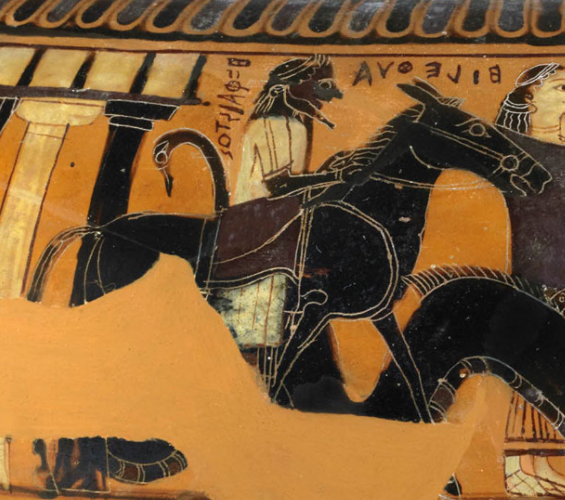
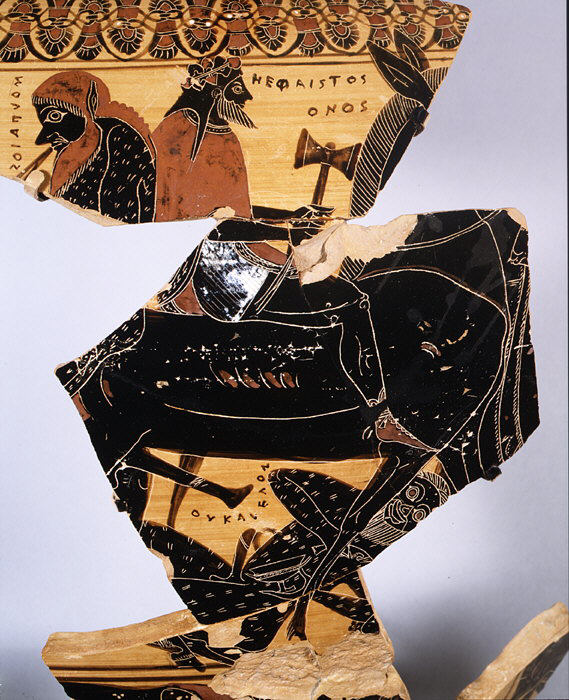
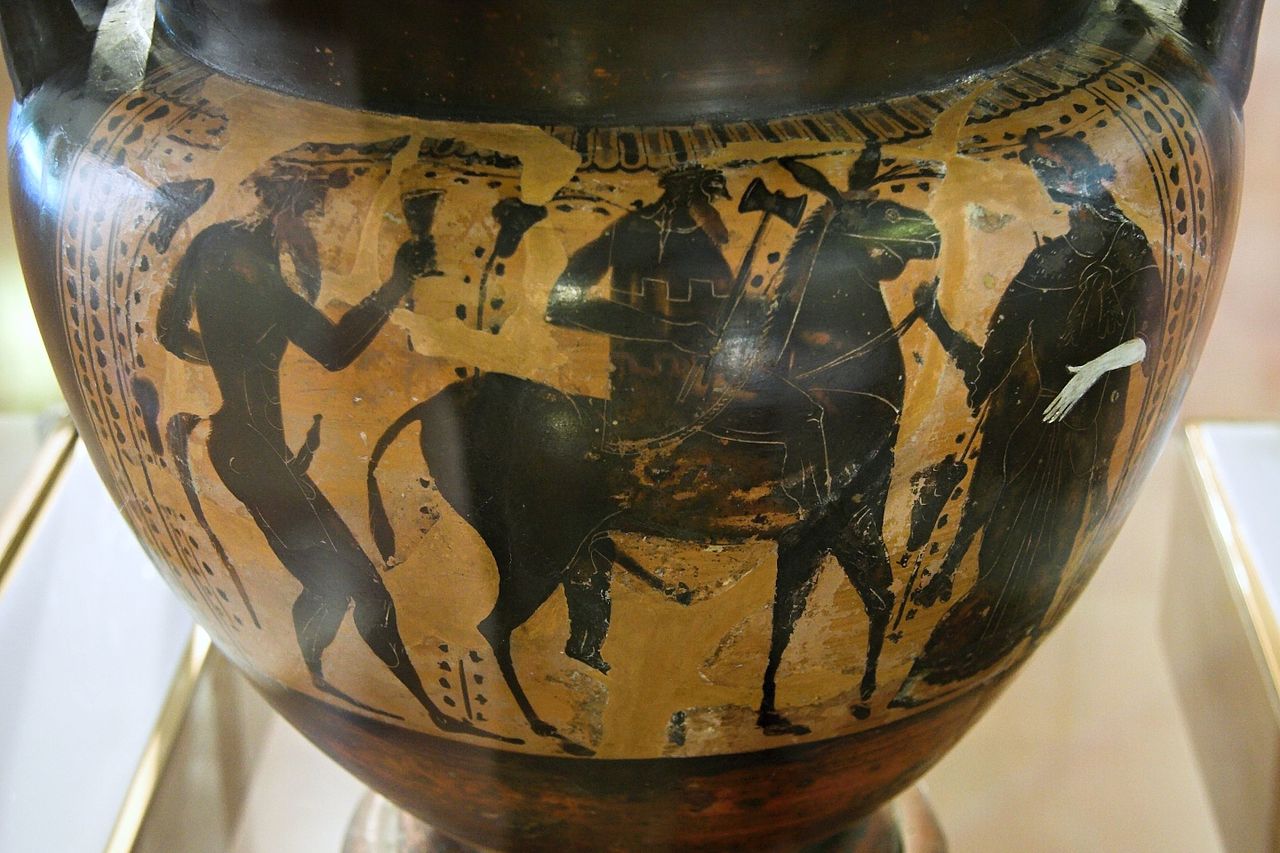
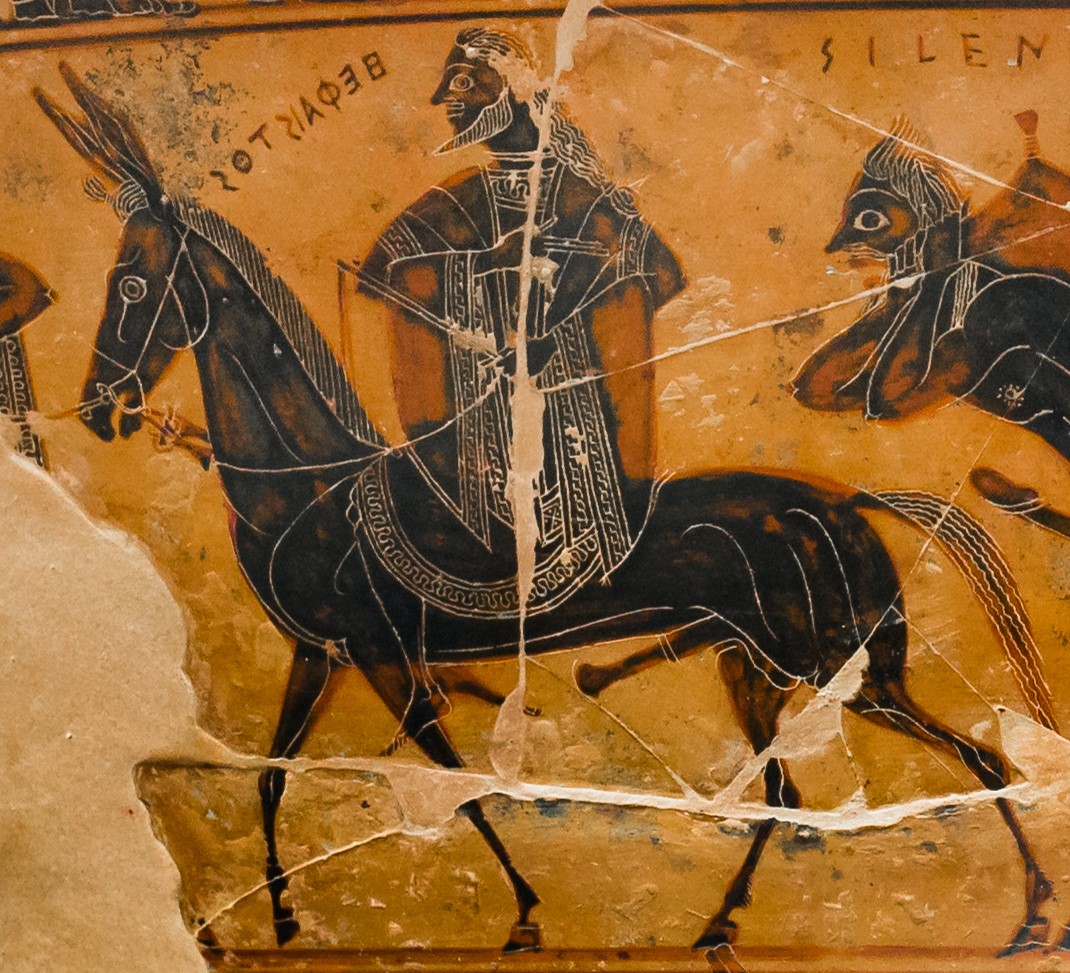
It was also not uncommon for Hephaestus to be depicted either riding a donkey or being helped by another mobility aid. Both are either references to his disability or, in depictions of his return to Olympus, references to his drunkenness.
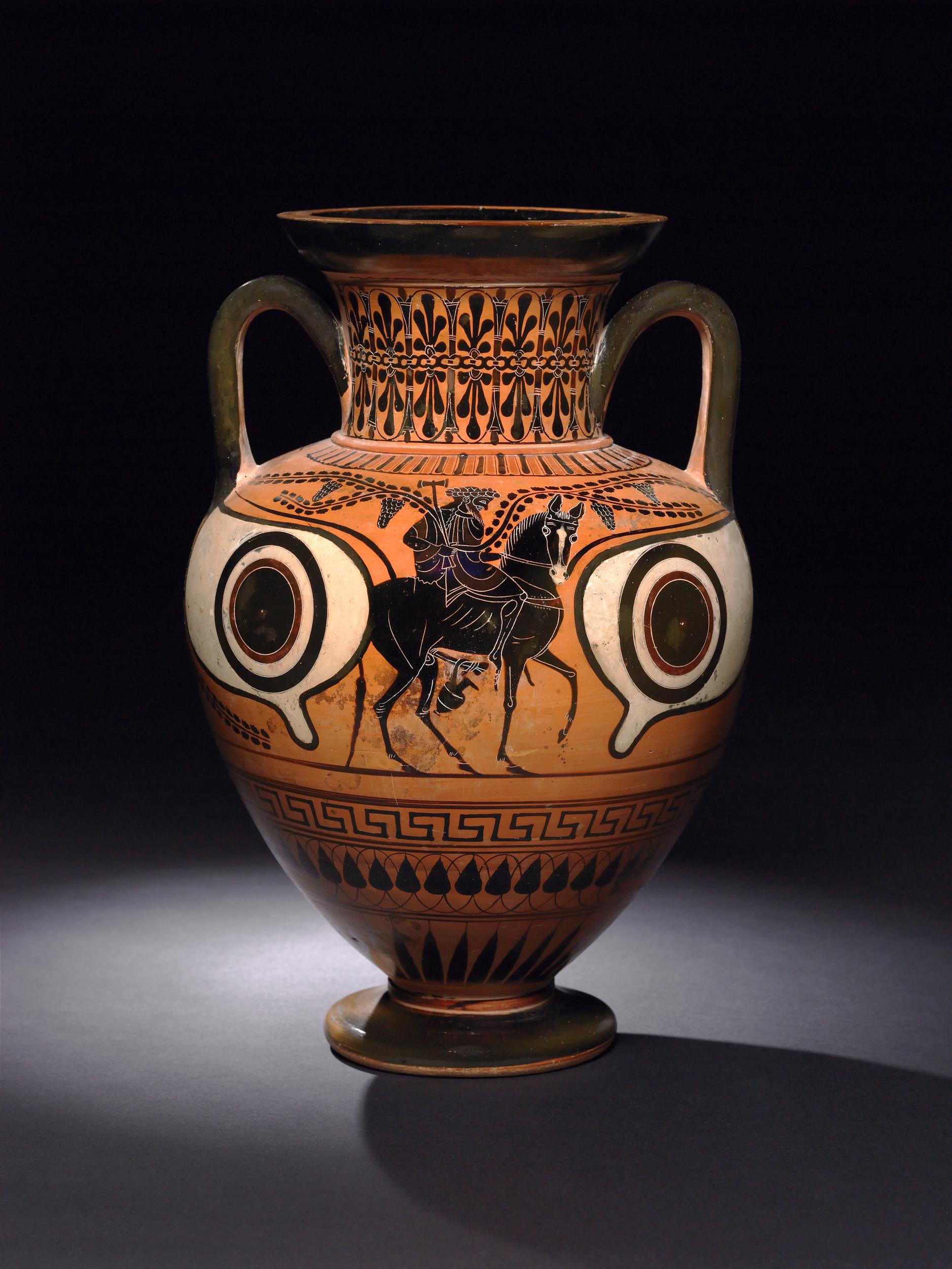
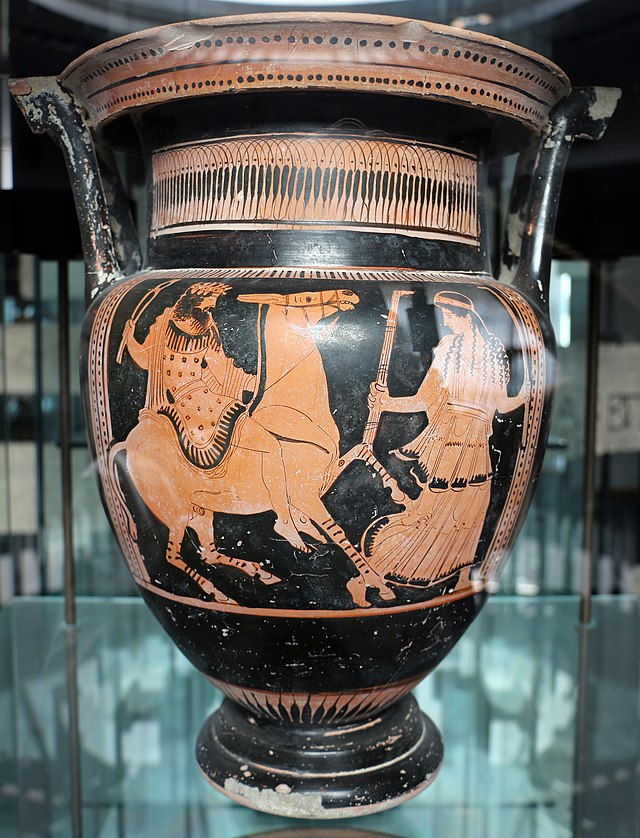
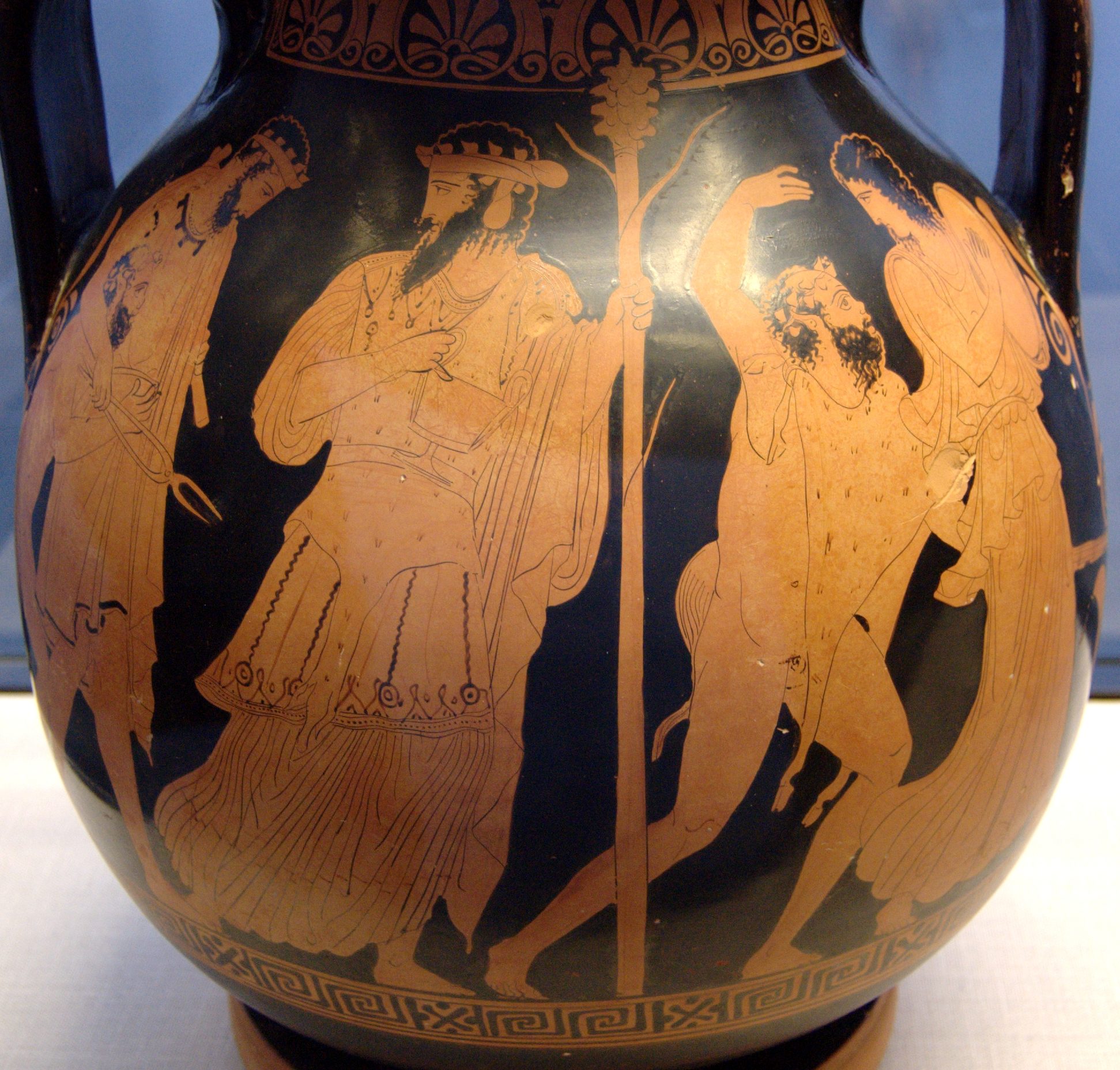
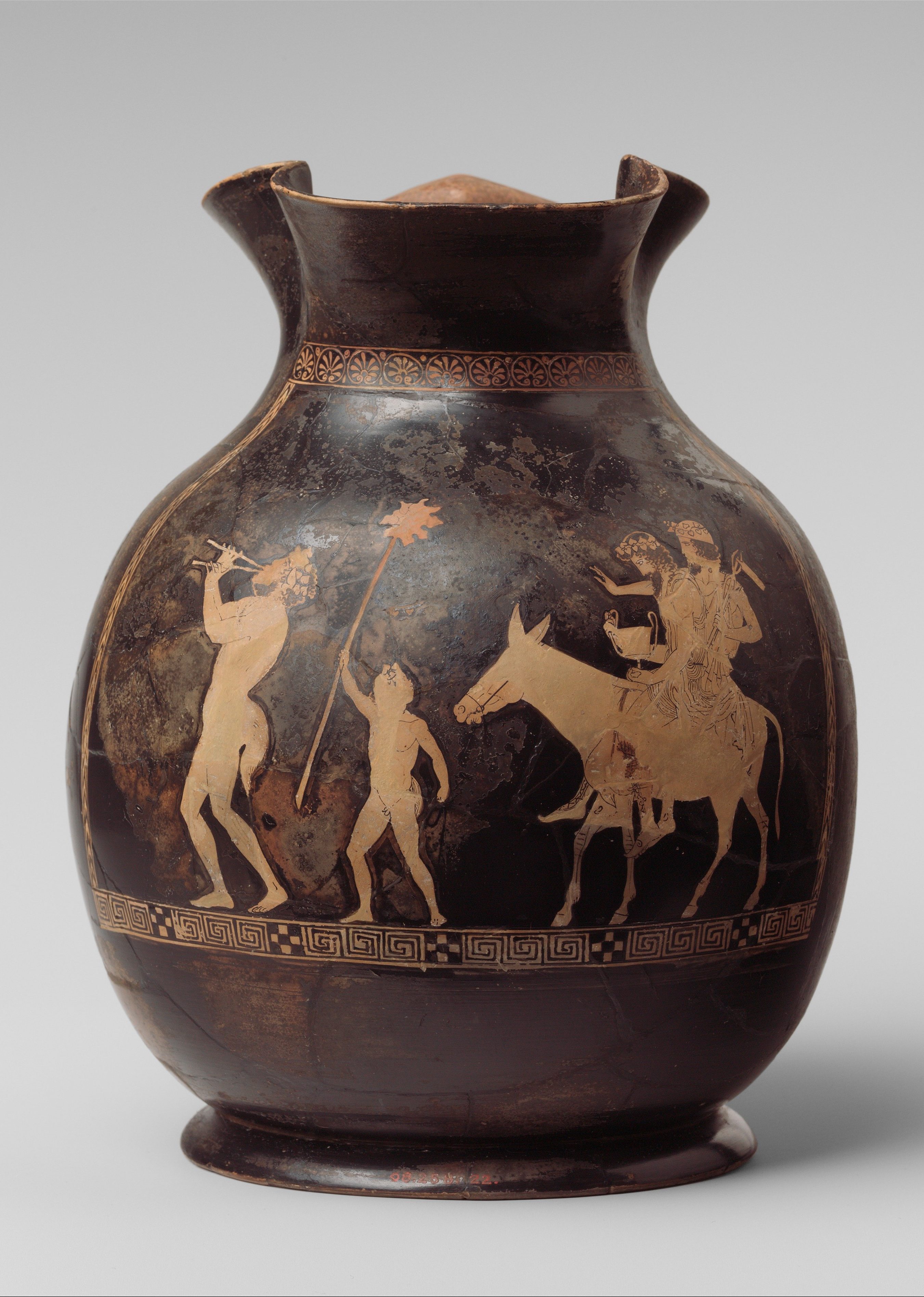
The mythical scenes involving Hephaestus are generally his return to Mount Olympus (in which he rides a donkey or mule and is accompanied by Dionysus and his retinue), the crafting of the new armour for Achilles, and the birth of Athena.
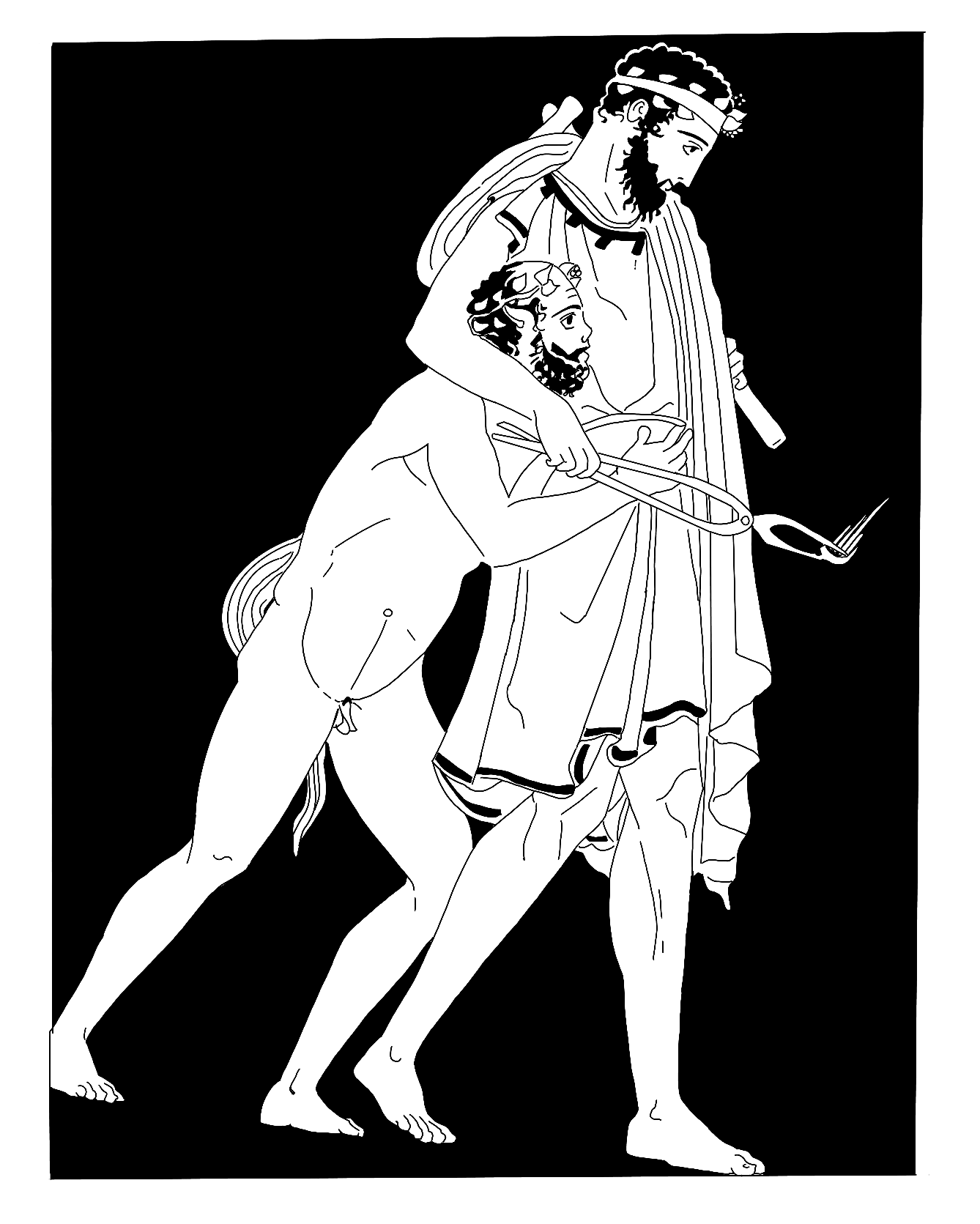
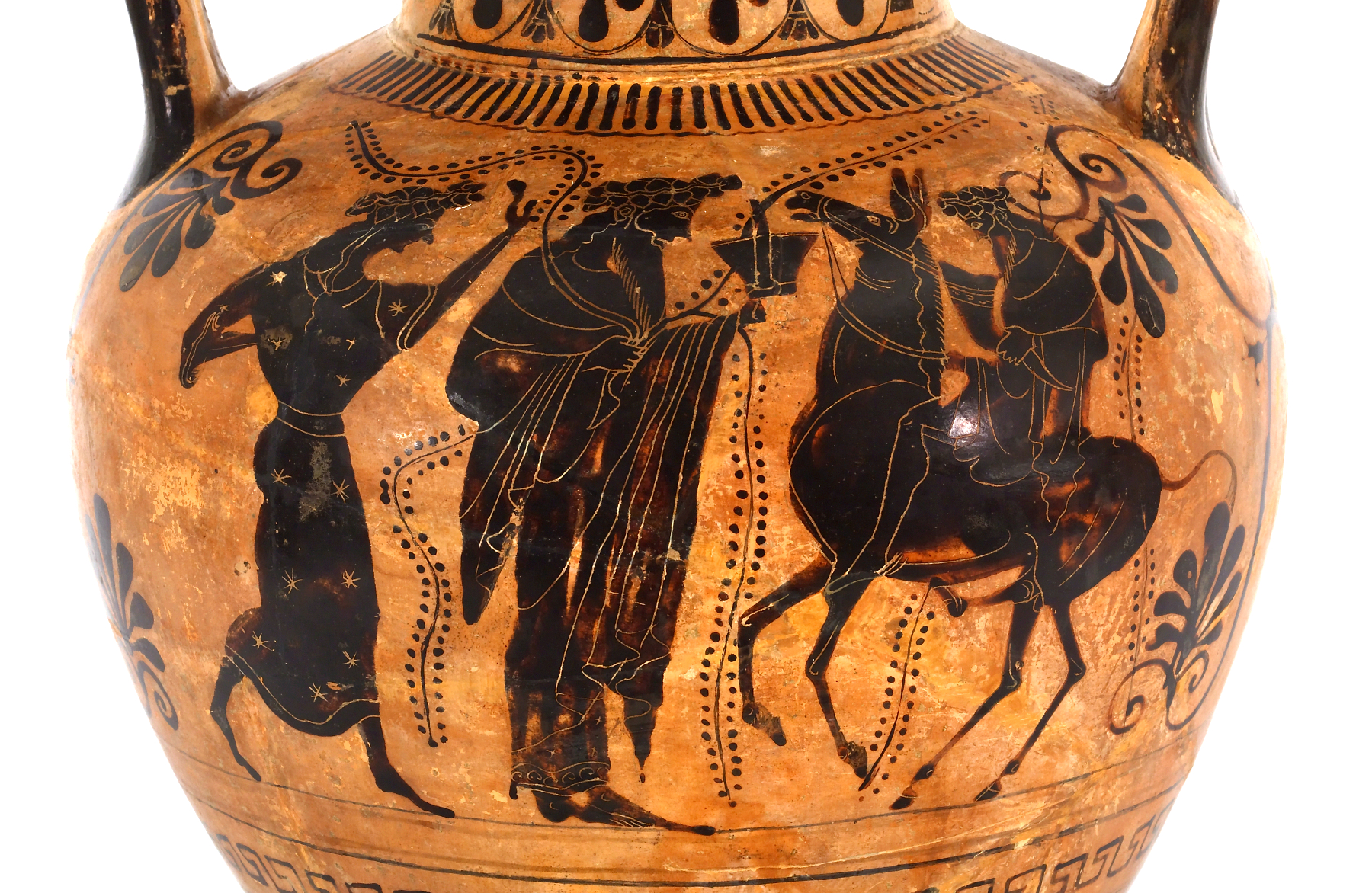
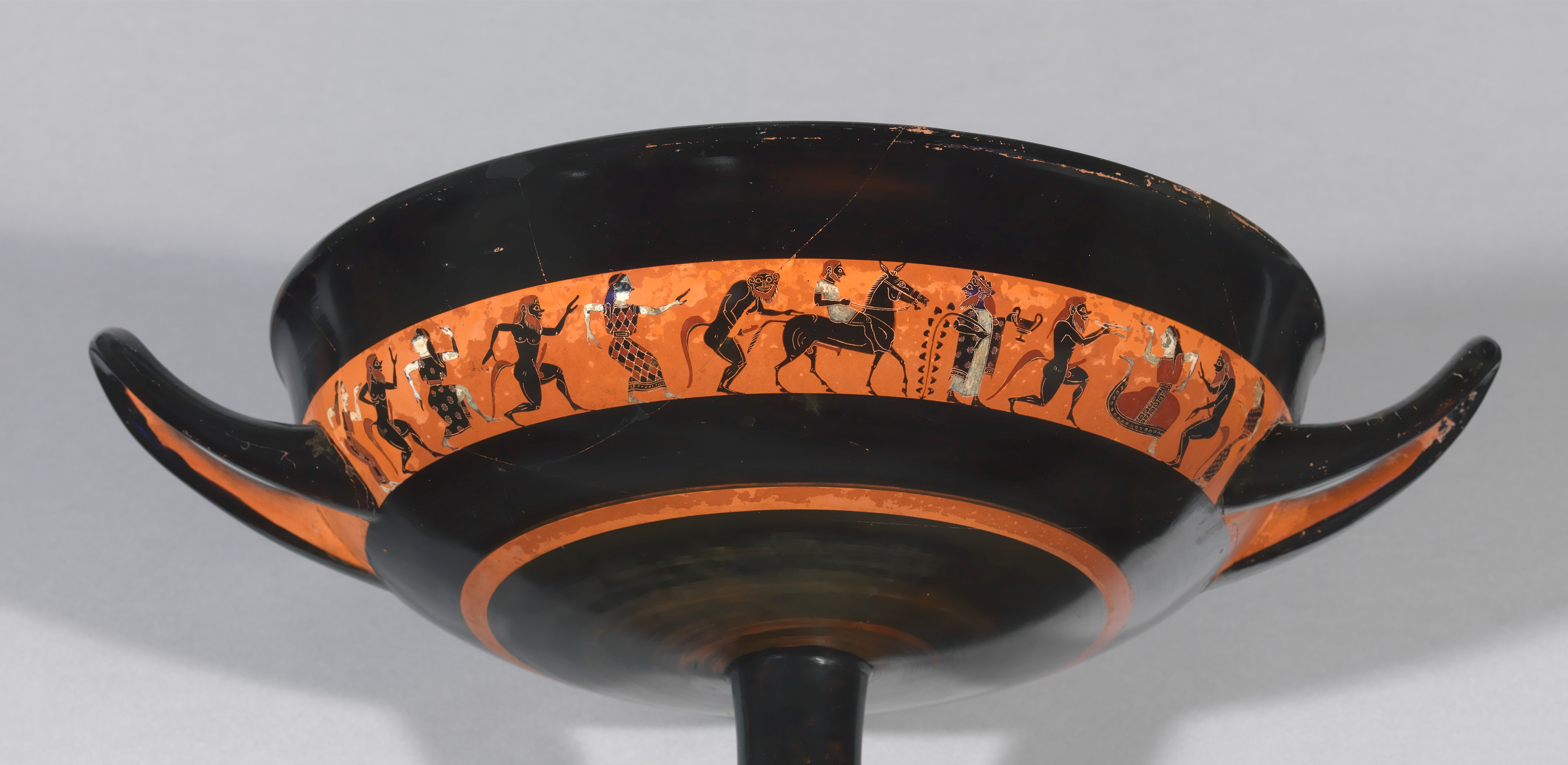
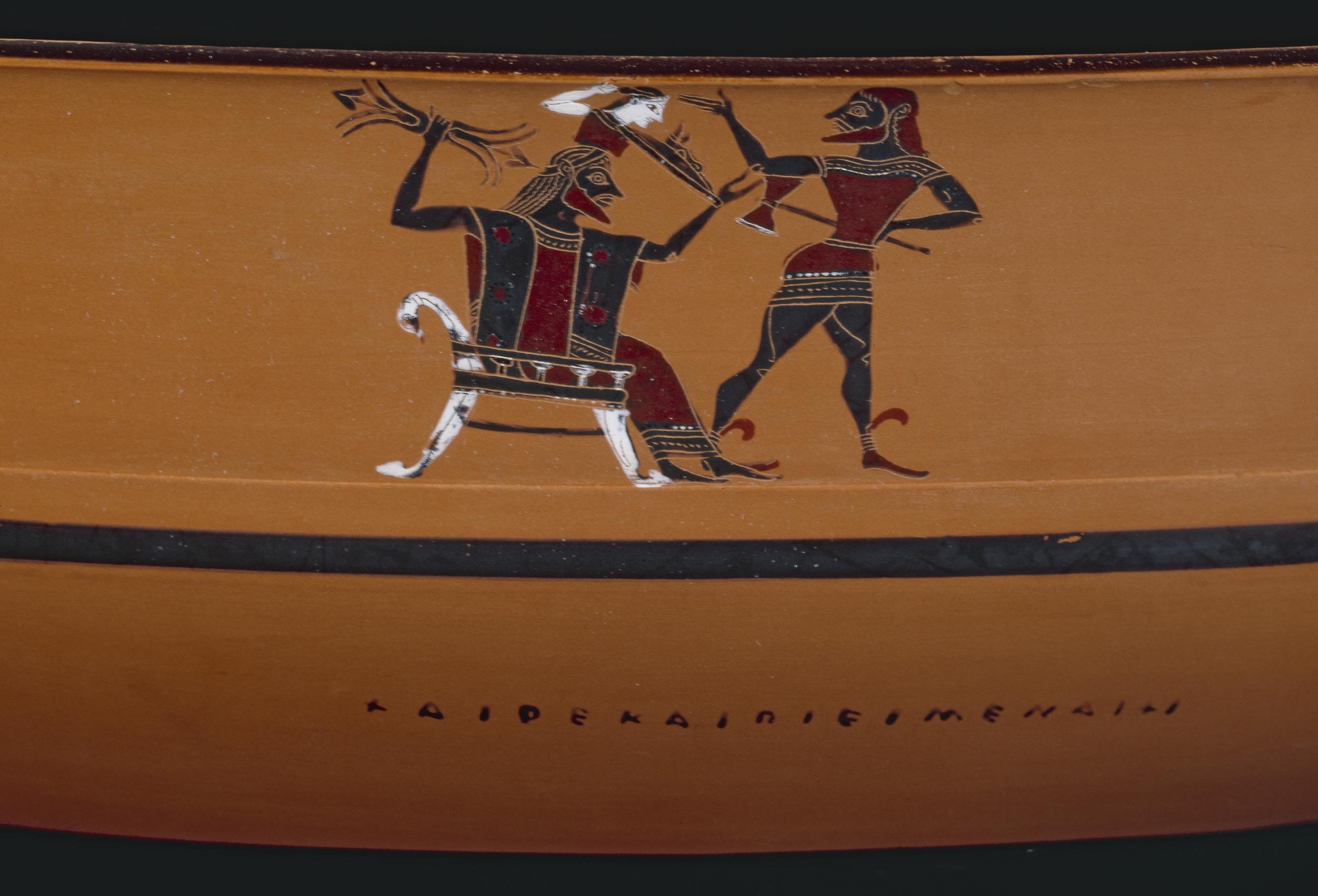
Vulcan
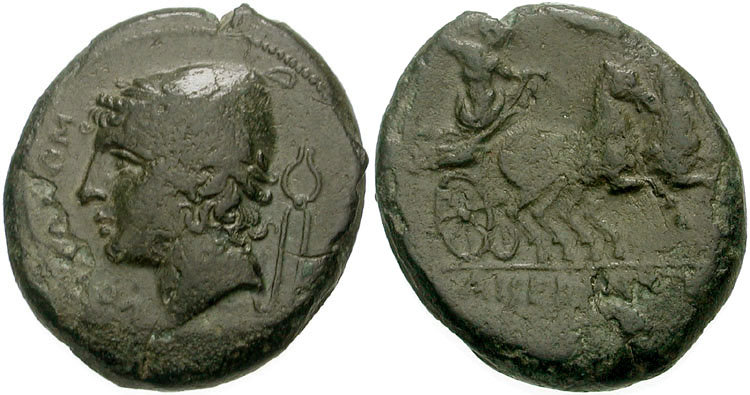
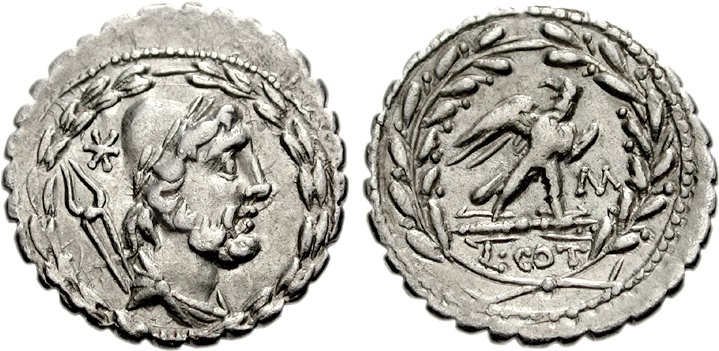
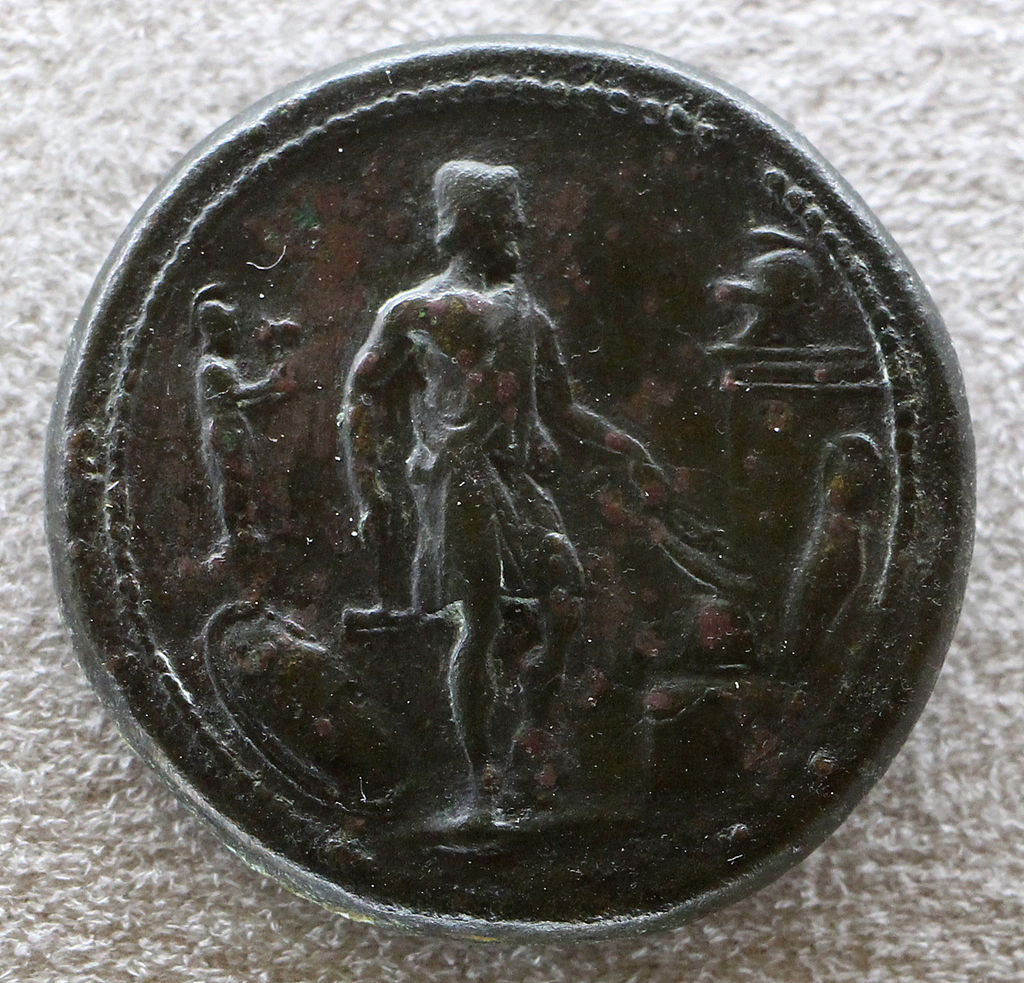
The iconography of the Roman equivalent god, Vulcan, did not change much from the Greek one. He continued to be represented as a mature, bearded man wearing a short craftsman tunic, a conical hat (pileus), and wielding the tools of his craft.
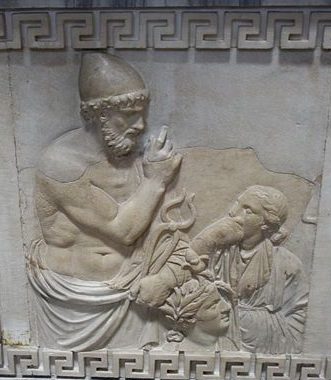
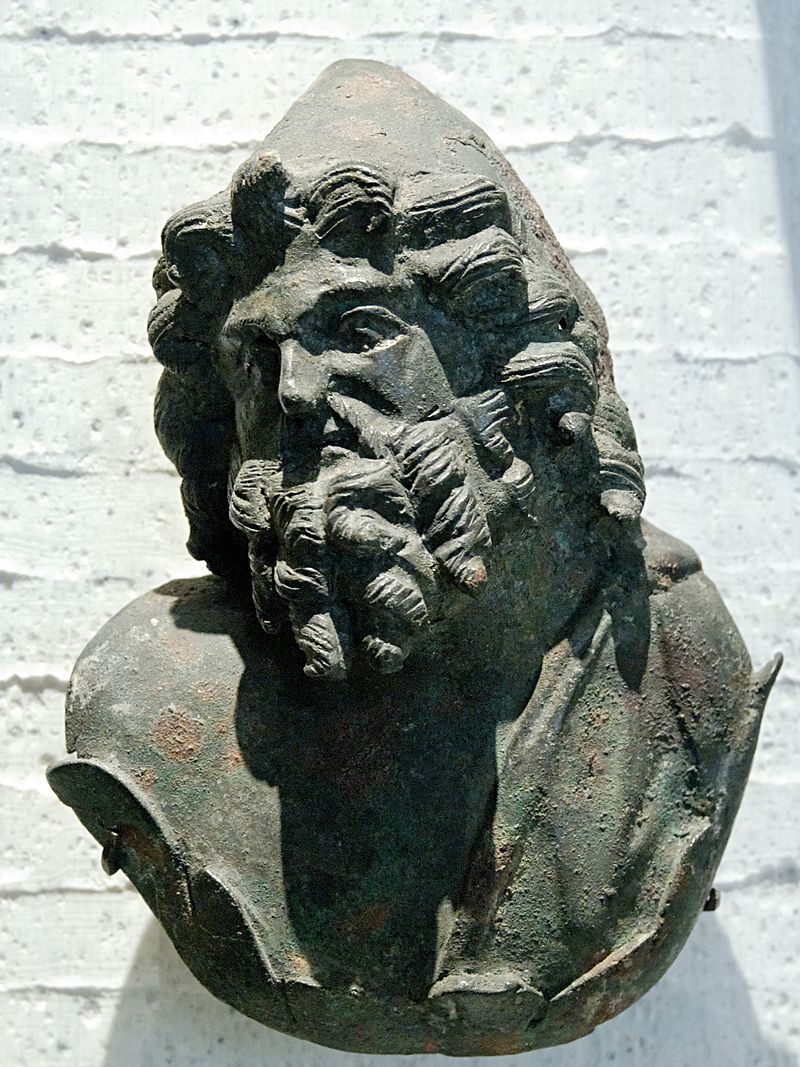
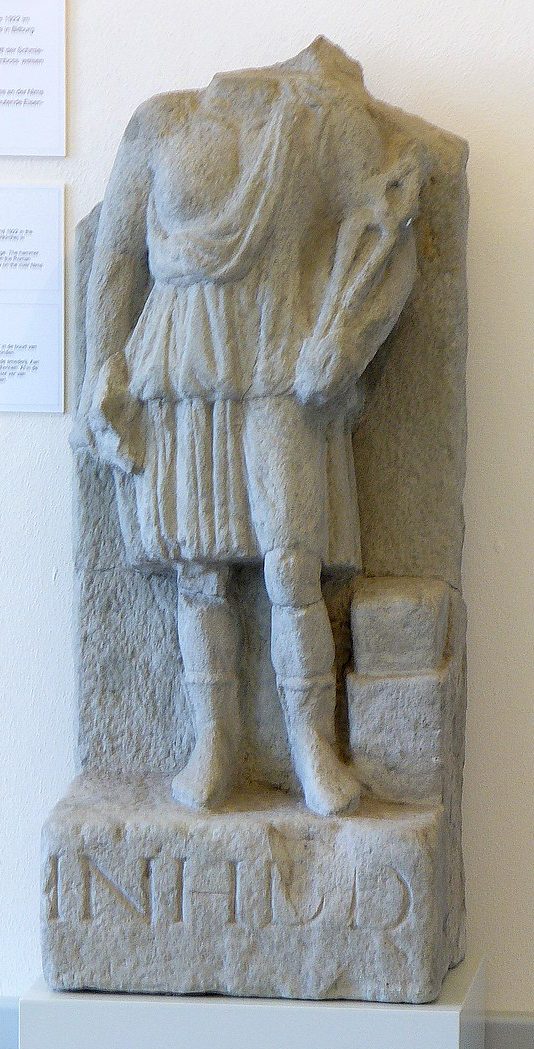
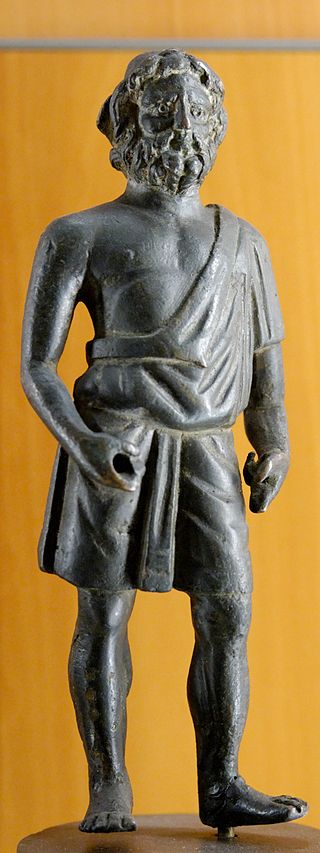
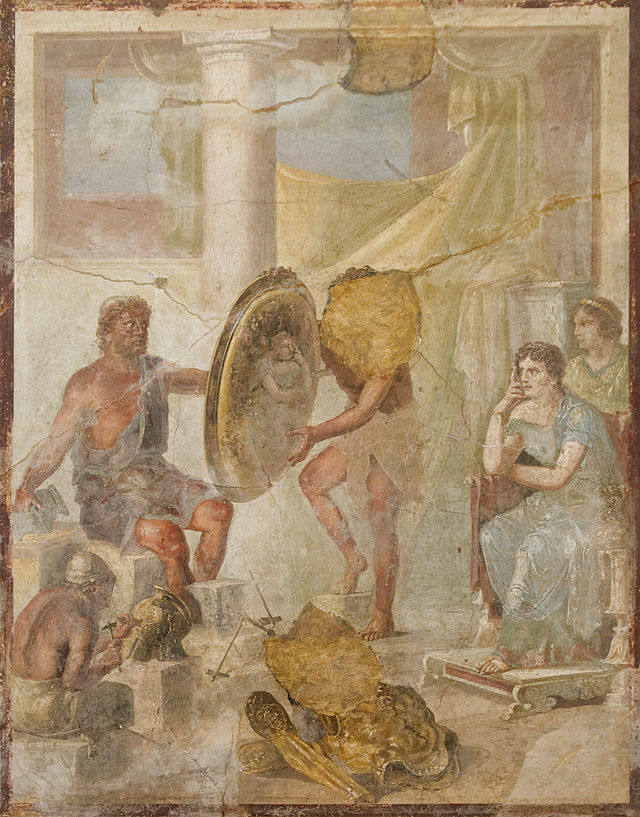
Media Attributions
Media Attributions
- Foundry Painter ARV 400 1 Hephaistos and Thetis – foundry (02) © ArchaiOptix is licensed under a CC BY-SA (Attribution ShareAlike) license
- Fregio con storie di atena ed efesto, II secolo, dalle terme del foro e le terme bizantine 06 © Sailko is licensed under a CC BY (Attribution) license
- Hephaestus in a Winged Chariot (Tracing) © Luoyao Zhang is licensed under a CC BY-SA (Attribution ShareAlike) license
- Dinos 1971,1101.1 © the British Museum is licensed under a CC BY-NC-SA (Attribution NonCommercial ShareAlike) license
- Fragmentary terracotta column-krater (bowl for mixing wine and water) MET GR237 © the Metropolitan Museum is licensed under a Public Domain license
- Colum crater, return of Hefaistos to Olympos, 550-500 BC, AM Agrigento, 550-500 BC, 120995 © Zde is licensed under a CC BY-SA (Attribution ShareAlike) license
- Kleitias – ABV 77 1 – compendium of Greek mythology – Firenze MAN 4209 – 40 © ArchaiOptix is licensed under a CC BY-SA (Attribution ShareAlike) license
- Neck-Amphora 1836,0224.48 © the British Museum is licensed under a CC BY-NC-SA (Attribution NonCommercial ShareAlike) license
- Pittore di orfeo, cratere attico con ritorno di efesto, 450-425 ac ca © Sailko is licensed under a CC BY (Attribution) license
- Return Hephaistos Staatliche Antikensammlungen 2361 © Bibi Saint-Pol is licensed under a Public Domain license
- Terracotta oinochoe: chous (jug) © the Metropolitan Museum is licensed under a Public Domain license
- Hephaestus Helped by a Satyr (Tracing) © Luoyao Zhang is licensed under a CC BY-SA (Attribution ShareAlike) license
- Antimenes Painter – Black-figure Amphora with Herakles and Apollo Fighting Over the Tripod – Walters 4821 – Detail B © Walters Art Museum is licensed under a Public Domain license
- Ariadne and Hephaistos with Dionysos Cup © the Metropolitan Museum is licensed under a Public Domain license
- Lip-Cup 1867,0508.962 © the British Museum is licensed under a CC BY-NC-SA (Attribution NonCommercial ShareAlike) license
- Aesernia Æ 139007 © the Classical Numismatic Group is licensed under a CC BY-SA (Attribution ShareAlike) license
- Aurelia 21 79000871 © the Classical Numismatic Group is licensed under a CC BY-SA (Attribution ShareAlike) license
- Medaglione di antonino pio, verso con vulcano nell’officina, statua di minerva, scudi, elmi, schinieri © Sailko is licensed under a CC BY (Attribution) license
- 6793 – Efesto(Museo Pio-Clementino) – Foto Giovanni Dall’Orto, 10 june 2011 © Giovanni Dall'Orto is licensed under a Public Domain license
- Applique Vulcanus Louvre Br39 © Marie-Lan Nguyen is licensed under a CC BY (Attribution) license
- Vulcanus Bitburg725 © QuartierLatin1968 is licensed under a CC BY-SA (Attribution ShareAlike) license
- Statuette Vulcanus MBA Lyon A1981 © Marie-Lan Nguyen is licensed under a CC BY (Attribution) license
- Achilles weapons MNA Naples © Marie-Lan Nguyen is licensed under a Public Domain license
Asexual reproduction, or the act of reproducing on one's own, without a partner.
The office or sphere of influence of an individual (generally a deity).
Nine deities of art, music, poetry, and creativity; daughters of Zeus and Mnemosyne.
Greek: Athena
Roman: Minerva
Goddess of warfare, wisdom, and craft.
See chapter 9.
Greek: Ares
Roman: Mars
God of war.
See chapter 10.
Greek: Aphrodite
Roman: Venus
Goddess of love and passion.
See chapter 4.
Greek: Helios
Roman: Sol (but in some Roman traditions equated with Apollo)
Personification of the sun.
Appears in chapter 10 and chapter 30.
Epithet for Aphrodite (see chapter 4), refers to her birth from the sea at Cythera.
Greek: Zeus
Roman: Jupiter or Jove
God of the sky, ruler of the Olympian gods.
See chapter 5.
Greek: Cronus
Roman: Saturn or Saturnus
Titan father of many of the gods, including Zeus and Hera. Son of Gaia and Uranus.
Featured in chapter 1.
Greek: Poseidon
Roman: Neptune
God of the sea.
See chapter 7.
Greek: Hermes
Roman: Mercury
God of travelers and trickery.
See chapter 16.
God of medicine, archery, oracles, and the sun.
See chapter 12.
Epithet for Hermes (see chapter 16), refers to his slaying of Argus Panoptes.
Called the Charites or Graces; three goddesses of beauty, charm, and grace.
A nereid, daughter of Nereus, and mother of Achilles. Known for raising Hephaestus.
Featured in chapter 8.
A mountain in Greece and the mythical home of the gods on this mountain.
An Oceanid, daughter of Ocean and Tethys, and mother of the Graces. Known for nursing Hephaestus when he was thrown from Olympus.
Featured in chapter 8.
Called Oceanus or Ocean.
The river encircling the earth or its personification as a Titan. Husband of Tethys and father of the Oceanids.
A king of Phthia and Argonaut. Father of Achilles, husband of Thetis, and son of Aeacus.
A king of Aegina, son of Zeus and Aegina, and father of Telamon and Peleus. Known for becoming a judge in the Underworld after his death.
Appears in chapter 41.
Called Troy or Ilium.
A city in Anatolia. Associated with Ilus and Dardanus, Priam and Paris, and the Trojan War.
See chapter 38. On the Trojan War, see chapters 25 to 30.
A king of Mycenae. Son of Atreus, brother of Menelaus, husband of Clytemnestra, and father of Iphigenia, Orestes, and Electra. Known for his participation in the Trojan War, for sacrificing his daughter Iphigenia, and for being killed by his wife Clytemnestra.
Featured in chapter 26, chapter 27, and chapter 30, and appears in chapter 41.
A woman of Lyrnessus, daughter of Briseus and slave of Achilles. Known for being the subject of the conflict that arose between Agamemnon and Achilles during the Trojan War.
A term to describe all the Greeks and people of Greek origin, notably the Greek armies in Homer's Iliad.
A Greek hero and son of Menoetius. Known for being a close companion (and possibly romantic and/or sexual partner) of Achilles, for fighting in the Trojan war, and for being killed by Hector.
Featured in chapter 27.
The soldiers under Achilles' command in the Trojan war.
A Trojan prince and hero, son of Priam and Hecuba, and husband of Andromache. Known for his role in the Trojan War, and for being killed by Achilles.
Featured in chapter 28 and chapter 29.
A group of 7 nymphs associated with stars and the night sky. Daughters of Atlas.
A group of nymphs of rain thought to have lived in Nysa. Daughters of Atlas. Known for helping raise Dionysus, and for being immortalized by Zeus as a constellation as a reward.
A legendary hunter. Known for his association with Artemis, for having his vision restored by Helius after he was blinded, and for being made into a constellation after he died.
Featured in chapter 13.
Greek: Eris
Roman: Discordia
Personification of conflict and strife. Known for provoking the Judgement of Paris at the start of the Trojan War.
Featured in chapter 26.
The Moirai or Fates: Clotho, Lachesis, and Atropos
Three goddesses who appear as old women and control the destinies of living things.
A son of Hermes, Apollo, Poseidon, or others in various traditions. Known for being a great musician, and for being killed either by Apollo, or by Heracles.
Featured in chapter 17.
Father of Icarus. Known for his great inventions, particularly creating the labyrinth of Minos.
Featured in chapter 22.
A princess of Crete, daughter of Pasiphae and Minos, and wife of Dionysus. Known for helping Theseus defeat the Minotaur.
Featured in chapter 22.
A Greek hero, son of Thetis and Peleus, and father of Neoptolemus. Known for his large role in the Trojan War.
Featured in chapter 27 and chapter 29.

